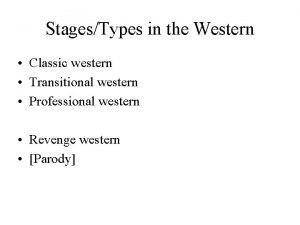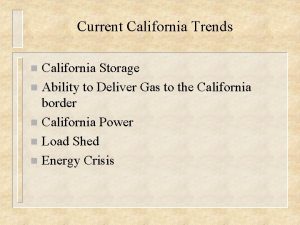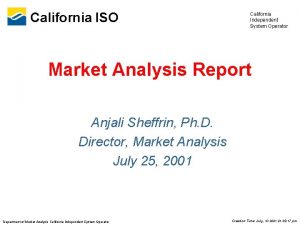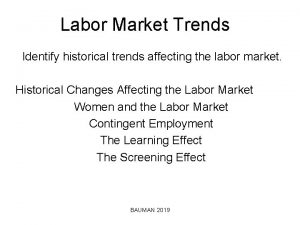California and the Western Market Trends and Opportunities



































- Slides: 35

California and the Western Market: Trends and Opportunities Independent Energy Producers Association Not at Fallen Leaf Lake September 23, 2020 Arne Olson, Senior Partner

2 Agenda 1. About E 3 2. Obligatory Section on Solar, the Duck Curve and Oversupply 3. Our Resources May Not Be Adequate 4. How Can We Dig Our Way Out? 2

1. About E 3

Who is E 3? Thought Leadership, Fact Based, Trusted. Technical & Strategic Consulting for the Clean Energy Transition 70 full-time consultants Deep expertise in engineering, economics, mathematics, public policy… San Francisco New York Boston 250 projects per year for our diverse client base 4

E 3’s expertise across our 5 practice areas gives us a unique perspective on the energy industry E 3’s project scope and breadth is unmatched for a firm of its size. We complete over 250 projects a year across the energy sector, emphasizing electricity E 3’s 30 -year track record and extensive expertise across our 5 practice areas has informed the creation of the market price forecasting tool Asset Valuation & Strategy Determines asset values and strategies from multiple perspectives Uses proprietary in-house models and in-depth knowledge of public policy, regulation and market institutions $ DERs & Rates Analyzes distributed energy resources, emphasizing their costs and benefits now and in the future Supports rate design and distribution system planning E 3 has five working groups which foster continual innovation in cutting-edge projects and best practices across the firm Resource Planning Develops and deploys proprietary tools to aid resource planners Informs longer-term system planning and forecasting ? Clean Energy Provides market and policy analysis on clean energy technologies and climate change issues Includes comprehensive and long-term GHG analysis Market Analysis Models wholesale energy markets both in isolation and as part of broader, more regional markets Key insights to inform system operators and market participants 5

E 3’s Three Core Client Types Investors, Developers & Asset Owners Public and Non -Profit Sector Utilities & System Operators 6

Public Service Announcement: TSA will not let you travel with a Magic 8 ball! A Magic 8 Ball contains approximately 100 m. L of liquid, or 3. 38 oz. TSA limits carry-on liquids to 3. 4 oz. 3. 38 < 3. 4 That doesn’t matter to TSA 7

2. Obligatory Section on Solar, the Duck Curve and Oversupply

9 One third of the way to SB 100! (The easy third) CEC estimates CA energy supply was 32% renewable in 2019 CA Energy Supply, 2019 • Majority of recent renewables growth has been in solar PV, both in front of and behind meter Solar already dominates daily energy market dynamics at just 12% wholesale penetration • Record-setting curtailment and negative pricing this spring Gas faces declining capacity factors as solar increasingly serves midday energy demand Source: CEC * Includes imports from out-of-state resources 9

Evolution of California’s Energy Market CAISO Hourly Solar Generation by Year (March-May only) Increasing solar and renewables penetration leads to mid-day over-generation and curtailment, leading to near $0 and negative prices during many daytime hours in recent years. SP 15 Day-Ahead Hourly Market Price (March-May only) Overgeneration increases the spread of energy prices and calls for generation with fastramping capability. Larger spreads across seasons will attract energy storage. Limited impact of solar PV on market pricing apparent at low penetrations High solar penetration suppresses prices in the middle of the day; prices close to 0 $/MWh, and then negative High hydro conditions lead to low spring prices CAISO Hourly Thermal Generation Dispatch by Year (March-May only) More pronounced dual peak days Thermal generation has been declining; plants must now frequently start multiple times a day to avoid low-to-negative prices during solar over-gen. As a result, generators are relying more on capacity payments. Minimum generation levels near zero during the middle of the day Source: CAISO, E 3 Analysis; note that solar generation does not include rooftop solar 10

Evolution of California’s Energy Market Curtailments have increased as CAISO’s gas fleet and imports must meet ramping needs from solar generation Curtailments (March-May only) Increased curtailment as CAISO is unable to utilize all solar generation Net Load (March-May only) >20 GW of daily ramping needs Decreased imports due to solar overgen in middle of day Imports (March-May only) Import / export reversal Source: CAISO, E 3 Analysis 11

1 2 Systemwide curtailment is on the rise due to solar overgeneration when load is low Peak of 320, 000 MWh/month = ~5. 5% of renewable generation in April 2020 Curtailment is increasing and spreading from spring to other seasons (fall, winter) 12

3. Our Resources May Not Be Adequate

1 4 Blackouts in California had its first rolling blackouts since 2001 on Aug. 14 -15 • Aug. 14 rolling blackout affected around 400, 000 homes and businesses across the state September 6 heat wave set California record temperatures, also leading to emergency conditions in CAISO PG&E cut power to 172, 000 homes and businesses on Sept. 8 to reduce wildfire risk 14

What is resource adequacy? Capacity is the ability to generate electric energy at any given point in time A system is “Resource Adequate” if it has sufficient capacity to serve load across a broad range of weather conditions The consequence of inadequate capacity is loss of load • Loss of load is inconvenient, expensive, and potentially lifethreatening Utilities plan their systems to ensure that loss of load occurs very rarely • E. g. , 1 -day-in-10 -years Source: http: //www. energy. siemens. com 15

1 6 California does not plan for 1 day in 10 years California uses a 15% Planning Reserve Margin (PRM) Unofficial modeling results indicate California may need a PRM of 17% or higher • CES 21, SERVM – RESOLVE calibration in IRP The 15% is applied by month • 1 -in-2 annual peak may be 1, 300 MW higher than highest 1 -in-2 monthly peak Median peak load forecast may not adequately address increasing frequency and intensity of heat storms Availability of imports will be lower in the future Month Median Peak Load (MW) June 40, 339 July 44, 004 August 44, 996 September 44, 704 Annual 46, 310 *Calculated using hourly load data from 2010 -2020 YTD **Summer includes June-September 16

California’s resource adequacy position is precarious CPUC ordered 3. 3 GW of RA procurement by 2023 along with an extension of OTC retirement dates to address a tightening of the near-term CAISO capacity balance Tightening attributed to • Reliance on an uncertain level of imports (West is increasingly tight due to coal retirements) • Hydro, within CA and in the NW, is in increasingly higher demand may be less able to meet system peaks that occur later in the year • Shifting of peak load later in the afternoon → lower solar ELCC CPUC is concerned with overreliance on RA imports to meet 2021 reliability (up to 8. 8 GW imports required) Source: CPUC, Assigned Commissioner and Administrative Law Judge’s Ruling Initiating Procurement Track and Seeking Comment on Potential Reliability Issues, June 20, 2019 (R. 16 -02 -007) • Retirement of a large amount of OTC capacity 17

The West: a rising tide lifts all boats The good • The broader West is beginning to follow California’s lead in clean energy policy • Cleaner, greenergy • Dirty coal going away • EIM is providing benefits The bad • Rapid pace of change and lack of meaningful regional planning and coordination has led to real economic and reliability risks that could hinder achievement of future RPS/GHG reduction goals The ugly • It is likely to get worse before it gets better The new Western grid will face increasing challenges through the mid-2020 s as both California and the surrounding regions commit to a more decarbonized grid heavily reliant on renewables and storage without a central coordination entity under a patchwork of different policies/laws/goals 18

External Context: Clean energy policies are reshaping the grid throughout the West Future renewable energy needs are defined in E 3 market price projections based on current and likely future policies • Current: CA SB 100, 60% by 2030, 86% by 2050 • Likely: OR carbon price, AZ 50% RPS by 2030 (recent ballot initiative) State RPS and CES* Policies as of Summer 2019 RPS/CES* Policy Scenarios State Requirement Effective RPS/CES Target for 2040 AZ 50% by 2030, 60% by 2040, 70% by 2050 IOU** 53% CA SB 100 (carbon price at CARB floor) 78% CO 30% by 2020; 50% by 2040; 100% for PSCO by 2050 50% ID 40% by 2040; 100% by 2050 IOU goal 72% MT 15% by 2015 for IOU; 40% by 2040 for IOU 75% NM 50% by 2030; 80% by 2040 100% clean by 2050 80% NV 50% by 2030; 100% by 2050 75% OR Tiered RPS requirement 50% by 2040 for large utilities 83% UT 20% by 2025 + utility goals 53% WA 15% by 2020; 100% by 2045 93% WY 40% by 2040 goals 53% *Clean Energy Standard **Investor Owned Utility 19

Let’s get regional: this is what’s happening in the Pacific Northwest “Top-Down” Regional Assessments 6, 000 – 8, 000 MW capacity need by 2030 “Bottom-Up” Review of Utility IRPs 9, 200 MW capacity need by 2030 Utility Planned Resource Additions Only 3, 300 MW effective capacity additions… 2, 800 MW of market purchases do not address regional need Source: E 3 analysis 1, 000 MW of 1, 500 MW firm gas capacity is proposed by OR/WA utilities that may face political opposition 20

2 1 Let’s get regional: this is what’s happening in the Desert Southwest E 3 analysis of DSW utility IRPs shows tight capacity balance today with large future deficit: 7+ GW by 2030 DSW Capacity Balance is Short 7 GW by 2030 Increasing capacity need through 2030 driven by load growth and coal retirements Planned near-term solar, storage, and gas additions are insufficient to meet entire capacity shortfall More solar and storage can likely meet all the needs through 2030 Source: E 3 analysis 21

4. How Can We Dig Our Way Out?

Structural Change: NW Power Pool is seeking to establish a regional RA program Currently, 19 funders of NWPP RA effort: • Avista, B. C. Hydro/Powerex, BPA, Calpine, Chelan PUD, Douglas PUD, EWEB, Grant PUD, Idaho Power, Northwestern Energy, NV Energy, Pacifi. Corp, Portland General Electric, Puget Sound Energy, SMUD/BANC, Seattle City Light, Snohomish PUD, Tacoma Power, Turlock Irrigation District Early program designs have both a binding forward showing and daily operational component 23

2 4 Physical Change: Accelerated Energy Storage Procurement New RA resources in CAISO are mostly limited to batteries • No new gas, near zero marginal ELCC from solar, in-state geothermal and wind mostly tapped out, reticence to over rely on imports Battery penetration in CAISO increased from 120 -140 MW in 2019 to ≈400 MW in so far in 2020. Most storage is providing regulation services. CAISO expects >900 MW of energy storage to come online by the end of 2020, CPUC 2019 -2020 RSP projects >10 GW by 2030 • CPUC ordered 3. 3 GW of RA procurement by 2023, most of it expected to be Storage / PV+S • LSEs have recently announced incremental >1. 5 GW of storage RA to come online in 2021 -2022 Source: CPUC IRP Proceeding 24

Battery storage costs show wide range, often already cheaper than gas today Cost of new entry for the cheapest frame combustion turbines (CTs) estimated at $90 to $140/k. W-yr E 3 Storage Cost Forecast Range • FERC-jurisdictional markets often publish formal cost metric • Generally more expensive estimates in higher-cost markets like CA, NY Cost new entry for battery storage projected to fall to under $100/k. W-yr by mid-2020 s • Wide range reflects cost uncertainty, differences in regional market costs • E 3 forecasts based on Lazard LCOS 5. 0 (Nov 2019) and NREL 2020 study – Levelized costs based on 20 Y asset life Storage PPAs today with 2021 -2023 CODs already pricing below E 3 low forecast bounds Data points on chart for 4 -hr storage costs include: EPE standalone project: storage PPA at $83/k. W-yr + $18/MWh EPE hybrid projects: solar PPA at $21/MWh, storage at $66/k. W-yr NVE hybrid projects: solar PPAs at $22 -24/MWh, storage at $82/k. W-yr PNM hybrid projects: solar PPAs at $19 -20/MWh, storage at $90 -120/k. W-yr PNM details "The 300 MW Arroyo PPA includes an energy purchase price of $18. 65/MWh, and the ESA charges a capacity price for the 40 MW of battery storage of $7. 46 k. W-month. The 50 MW Jicarilla PPA includes an energy purchase price of $19. 73/MWh and the ESA charges a capacity price for the 20 MW of battery storage of $9. 97 k. W-month" 25

2 6 What is storage doing today? Around 400 MW of batteries active in CAISO market today Primarily providing ancillary services: frequency regulation, spinning reserves, etc. , and dispatching occasionally in RT markets • No deep daily cycling and ramping trend yet, even on days with biggest duck curve • Biggest sources of system flexibility are still gas, hydro, and imports Storage capacity will grow rapidly in next few years and typical operations are likely to change Typical Battery Dispatch in California Market in 2019 26

Energy Storage will continue to grow, but use cases will change Ancillary services value will decline as markets get saturated Capacity services expected to grow as storage provides resource adequacy needs Renewable build-out driven by low-cost solar creates significant long-term value and need to store midday energy for night-time use (DA arbitrage) Market Size/Value T&D deferrals offer additional value to projects, especially for local capacity Illustrative Evolution of Storage Demand: Front-of-Meter (bulk system) 2030: • New capacity: storage competes as marginal capacity resource 2025: • Replacement capacity for old peaking units • Renewable integration drives demand for storage via energy arbitrage, esp. solar • Renewable integration • Ancillary services • T&D deferrals 2019: • Ancillary services • Policy targets and subsidies • Capacity • T&D deferrals Ancillary Services Time 27

Cost and limitations of serving RA needs with energy storage Ability of storage to provide RA is initially high, but ELCC degrades with increasing penetration due to energy-limited nature of storage • Energy limited nature of storage and peak flattening → diminishing returns to effective capacity • Cost of new entry of storage per effective MW of new capacity increases as marginal ELCC declines, while cost of new entry of gas remains about the same As a result, longer and longer duration storage is needed over time to provide same capacity credit, driving up the cost of capacity provided by storage 8 -hr storage Gross CONE ranges from ~$200/k. W-yr today to $140/k. W-yr by 2030 Energy Storage ELCC Progression in California 100% >10 GW of storage expected by 2026 according to CPUC IRP 80% ELCC % • Average ELCC Marginal ELCC 60% 40% 2025 Storage Penetration 20% 2030 Storage Penetration 0% 0% 10% 20% 30% 40% 50% 60% % of Peak 70% 80% 90% 100% Source: E 3 28

Energy Storage Archetypes Two most competitive archetypes for meeting long term storage demand: 1) Large (100+ MW) solar-storage hybrids – Shared cost savings and tax credits make solar-hybrids the cheapest form of storage today – Clipped energy from DC-coupled storage can boost value of hybrid solar systems – Economies of scale for interconnection, storage procurement, EPC and overhead 2) Medium-to-large (20 -800 MW) standalone storage at existing POIs in congested load pockets where solar-hybrids are less viable – Repowering of gas (or coal, nuclear) POIs offers cost savings, premium injection points – Deployment in load pockets can offer premium for local capacity value, congestion pricing – Economies of scale for interconnection, storage procurement, EPC and overhead Approximate market share breakdown will vary by system, but expectation is that majority of capacity will be solar-storage hybrid with remainder being standalone storage in load pockets 29

3 0 Hybrid vs Standalone Storage Currently there are ≈ 400 -500 MW of batteries operating in CAISO Storage Projects • Most batteries are standalone batteries providing frequency regulation services There are roughly 3. 4 GW of storage capacity either under construction or that have been awarded a PPA • Will likely reach COD between 2020 -2023 • Roughly 50/50 breakdown between hybrids and standalone based on storage capacity Standalone storage projects are located near locally-constrained pockets • Projects are repurposing existing sites (Moss Landing, Gateway, Diablo, Alamitos) CAISO Interconnection Queue • 69, 193 MW of energy storage in queue (51% hybrid) • Storage is included in two-thirds of all new solar and onehalf of all new wind resources Source: Based on data from SNL, CAISO Type Operating Construction / PPA Standalone ≈ 400 MW ≈ 1, 720 MW Hybrid* ≈ 50 MW ≈ 1, 700 MW *Only includes storage capacity 30

PV+S projects offer tangible cost savings vs. standalone storage Cost savings Approximately 7% capex savings advantage for storage sited with solar • Likely opex savings as well DC-coupling may offer greater savings through more shared balance of plant • Also enables harvest of clipped solar energy, though potential reduction in operational flexibility Tax advantages Source: 2018 US Solar-plus-Storage System Costs Benchmark (NREL) ITC is available to PV-paired storage, 30% tax credit on capex through 2024, stepping down to 10% thereafter Accelerated depreciation incentives may apply as well Source: NREL, Federal Tax Incentives for Energy Storage Sytems ( https: //www. nrel. gov/docs/fy 18 osti/70384. pdf ) 31

Large standalone storage development faces competition with projects at existing gas plants Opportunity for large standalone storage projects will be concentrated in load pockets where local RA needs, congestion, and high cost of new transmission/distribution drive premium value • Leading markets today include Southern California and the Bay Area Largest standalone projects have been sited at existing or retiring thermal plants where interconnection cost is low. Projects not co-located with a thermal generator are often “downstream” from a retiring generator and benefit from same existing transmission Market for standalone storage outside large projects at existing POIs may be limited • In NYC for example, LS Power is developing 316 MW battery at Ravenswood gas plant that would singlehandedly fill Con. Ed’s 300 MW procurement target for current RFP Largest California Standalone Storage Projects Recently Procured Co-located with existing gas plant Developer Project Contracted Capacity COD Offtaker Planned Expansion Vistra Moss Landing 400 MW / 1, 600 MWh 2020/21 PG&E Yes LS Power Gateway 150 MW / 600 MWh 2021 SCE / PG&E Yes LS Power Diablo 150 MW / 600 MWh 2021 PG&E Yes AES Alamitos 100 MW / 400 MWh 2021 SCE Yes s. Power/AES Luna 100 MW / 400 MWh 2021 CPA No Strata Saticoy 100 MW / 400 MWh 2021 SCE No es. Volta Hummingbird 75 MW / 300 MWh 2021 PG&E No Vistra Oakland 36 MW / 145 MWh 2022 EBCE / PG&E Yes 73% of contracted capacity for standalone projects >100 MWh filled by storage projects at existing gas plant POIs 32

3 3 AS Market saturation will happen quickly Total CAISO wholesale market cost was ~$8. 9 bn in 2019 Product Market size DA Energy $8. 3 B RT Energy $218 M AS+RUC $160 M Uplift Costs $124 M ~$350 -500 M/yr of potential value in RT and AS markets Opportunity cost principles imply that these markets progressively saturate together Regulation market in 2019 was $80 -90 M with ~400 MW of avg requirement Assuming value of storage is ~$180/kw-year in 2020 • Implies 2 -3 GW of energy storage to fully saturate these markets • PV+storage may not always participate in the RT/AS markets so may not contribute to the saturation on a 1: 1 basis – PV+S are only subject to ITC charging restrictions for first 5 years Amount of storage projected in CA can only be sustained in Energy DAM 33

RA Market Dynamics Under High Storage Penetration E 3 expects the RA market in California to go through 3 phases: § Short Term: Tight RA conditions due to OTC & Nuclear retirements; new storage and PV+S is built to replace capacity. Storage sets RA prices for new build; gas going-forward costs for existing RA. § Medium Term: Solar and Storage build is driven by RPS targets; potential surplus conditions forces retirement of gas. RA prices expected to dip below going-forward costs of gas. § Long Term: Growth in electric vehicles and electrified building loads drives increasing RA needs. marginal storage receives low capacity credit; as NQC value decreases, existing gas becomes the lowest cost source of capacity. Storage Net Cost of New Entry Marginal Cost of System RA from Existing Gas vs. New Storage Capacity, $/k. W-mo Ne set t cos ting t of cei stor ling age on e RA xcee pri ds g 1 ces as tas e l r e ge du on RA l C no of ge rce ELC a r u d o St st so rate o c satu to 3 2 , Valley of death for gas plants Storage offers least-cost short-term RA value, leading to some subset of RA contracts at prices below carrying cost of existing gas Time 34

Thank You! Energy and Environmental Economics, Inc. (E 3) 44 Montgomery Street, Suite 1500 San Francisco, CA 94104 Tel 415 -391 -5100 Web http: //www. ethree. com Arne Olson, Senior Partner (arne@ethree. com)
 Observing trends in entrepreneurship
Observing trends in entrepreneurship Positioning and targeting
Positioning and targeting Market leader follower challenger nicher
Market leader follower challenger nicher Chapter 9, section 1: labor and wages worksheet answers
Chapter 9, section 1: labor and wages worksheet answers Example of market size
Example of market size Western wholesale market
Western wholesale market Ontogenetic market size
Ontogenetic market size Nystagmus market trends
Nystagmus market trends Enterprise collaboration market trends
Enterprise collaboration market trends Emerging trends meaning
Emerging trends meaning Laminated veneer lumber market trends
Laminated veneer lumber market trends Series compensation system market trends
Series compensation system market trends Computational creativity market trends
Computational creativity market trends Agnosia treatment market trends
Agnosia treatment market trends Probiotics market share
Probiotics market share Introduction of labor
Introduction of labor Evaluating opportunities in the changing market environment
Evaluating opportunities in the changing market environment Identify market opportunities
Identify market opportunities Hình ảnh bộ gõ cơ thể búng tay
Hình ảnh bộ gõ cơ thể búng tay Frameset trong html5
Frameset trong html5 Bổ thể
Bổ thể Tỉ lệ cơ thể trẻ em
Tỉ lệ cơ thể trẻ em Chó sói
Chó sói Thang điểm glasgow
Thang điểm glasgow Chúa yêu trần thế alleluia
Chúa yêu trần thế alleluia Các môn thể thao bắt đầu bằng tiếng đua
Các môn thể thao bắt đầu bằng tiếng đua Thế nào là hệ số cao nhất
Thế nào là hệ số cao nhất Các châu lục và đại dương trên thế giới
Các châu lục và đại dương trên thế giới Cong thức tính động năng
Cong thức tính động năng Trời xanh đây là của chúng ta thể thơ
Trời xanh đây là của chúng ta thể thơ Mật thư tọa độ 5x5
Mật thư tọa độ 5x5 101012 bằng
101012 bằng độ dài liên kết
độ dài liên kết Các châu lục và đại dương trên thế giới
Các châu lục và đại dương trên thế giới Thể thơ truyền thống
Thể thơ truyền thống Quá trình desamine hóa có thể tạo ra
Quá trình desamine hóa có thể tạo ra



























































